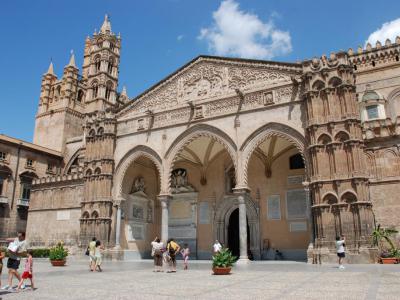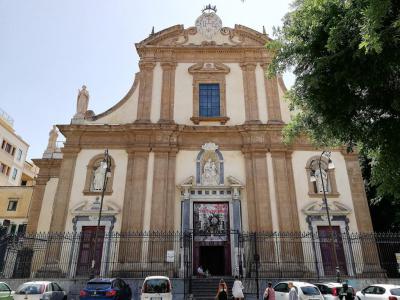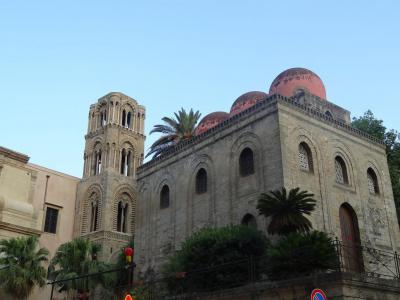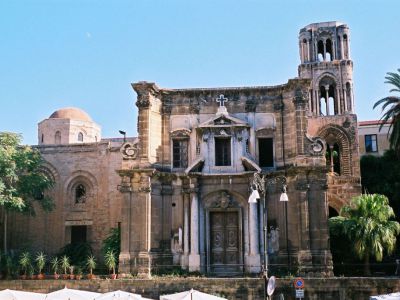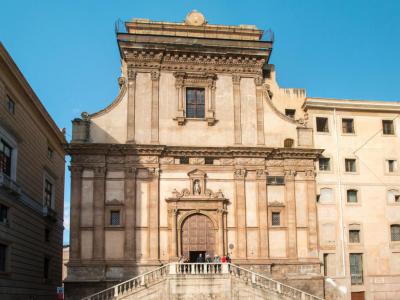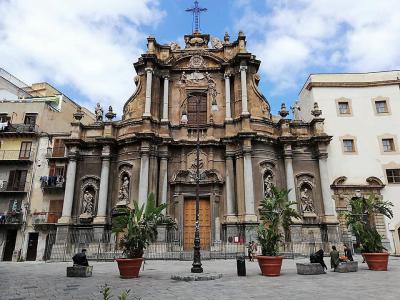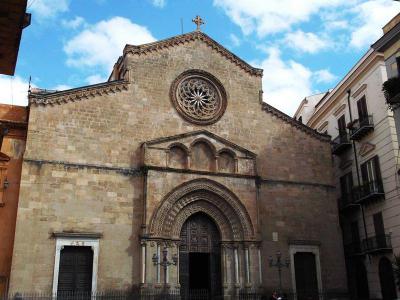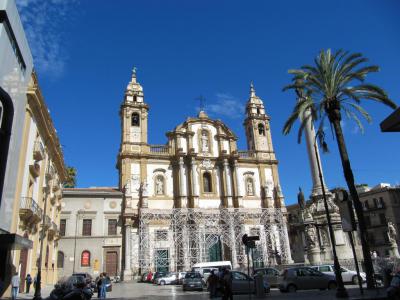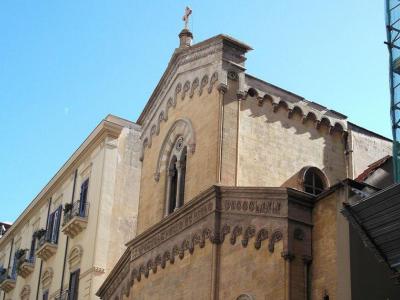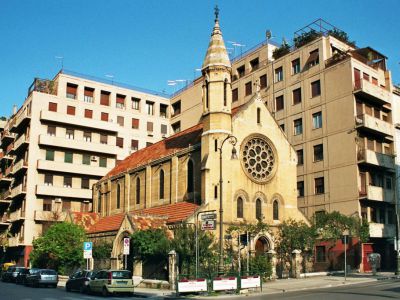Historical Religious Buildings (Self Guided), Palermo
Religion has always played an important role in the lives of the Italians – and the Sicilians are no exception. Thus, it is little wonder that the main city of the island, Palermo, boasts a plethora of religious buildings. The collection of historical churches found here ranges from the Arab-Norman-Byzantine to the Medieval, Gothic, Baroque and the Renaissance.
In the course of history, many of the local temples have been demolished, abandoned or deconsecrated, or, as during the Arab occupation, converted to mosques. Eventually restored to their original denomination, some of them, after the unification of Italy in 1861, were confiscated by the state. Still, the majority of the artistic treasures held there have survived and today make up the bulk of the historic and artistic heritage of Palermo.
Running the risk of being spoiled for choice, here are some of the most important churches in the historic heart of Palermo you may not want to miss:
Palermo Cathedral – a colorful mixture of architectural styles; home to the relics of the patron Saint of Palermo, Santa Rosalia, and more;
Chiesa del Gesù – a 16th-century Jesuits Church, one of the most important Baroque temples in Sicily; inside, expect one of these “jaw-dropping moments”, as the interior is truly overwhelming;
San Cataldo Church – founded in 1160, a perfect example of Norman architecture;
La Martorana (Martorana Church) – famous for its interior, featuring a series of superb Byzantine mosaics;
Santa Caterina Church – a Grand Catholic Dominican church with ornate decor and collection of precious artworks.
San Francesco d'Assisi Convent – one of the few buildings remaining from the Renaissance era;
Chiesa San Domenico (San Domenico Church) – known locally as the "Pantheon of Illustrious Sicilians", the final resting place of many prominent figures in Sicilian history.
Chiesa Anglicana (Anglican Church) – built in 1872, the only Anglican church in Palermo.
Make sure to spare some of your time to explore at least some of these religious sights, if not all of them – well worth visiting, indeed. You are not going to be bored! Just take this self-guided walking tour and see for yourself.
In the course of history, many of the local temples have been demolished, abandoned or deconsecrated, or, as during the Arab occupation, converted to mosques. Eventually restored to their original denomination, some of them, after the unification of Italy in 1861, were confiscated by the state. Still, the majority of the artistic treasures held there have survived and today make up the bulk of the historic and artistic heritage of Palermo.
Running the risk of being spoiled for choice, here are some of the most important churches in the historic heart of Palermo you may not want to miss:
Palermo Cathedral – a colorful mixture of architectural styles; home to the relics of the patron Saint of Palermo, Santa Rosalia, and more;
Chiesa del Gesù – a 16th-century Jesuits Church, one of the most important Baroque temples in Sicily; inside, expect one of these “jaw-dropping moments”, as the interior is truly overwhelming;
San Cataldo Church – founded in 1160, a perfect example of Norman architecture;
La Martorana (Martorana Church) – famous for its interior, featuring a series of superb Byzantine mosaics;
Santa Caterina Church – a Grand Catholic Dominican church with ornate decor and collection of precious artworks.
San Francesco d'Assisi Convent – one of the few buildings remaining from the Renaissance era;
Chiesa San Domenico (San Domenico Church) – known locally as the "Pantheon of Illustrious Sicilians", the final resting place of many prominent figures in Sicilian history.
Chiesa Anglicana (Anglican Church) – built in 1872, the only Anglican church in Palermo.
Make sure to spare some of your time to explore at least some of these religious sights, if not all of them – well worth visiting, indeed. You are not going to be bored! Just take this self-guided walking tour and see for yourself.
How it works: Download the app "GPSmyCity: Walks in 1K+ Cities" from Apple App Store or Google Play Store to your mobile phone or tablet. The app turns your mobile device into a personal tour guide and its built-in GPS navigation functions guide you from one tour stop to next. The app works offline, so no data plan is needed when traveling abroad.
Historical Religious Buildings Map
Guide Name: Historical Religious Buildings
Guide Location: Italy » Palermo (See other walking tours in Palermo)
Guide Type: Self-guided Walking Tour (Sightseeing)
# of Attractions: 10
Tour Duration: 2 Hour(s)
Travel Distance: 3.2 Km or 2 Miles
Author: Lilly
Sight(s) Featured in This Guide:
Guide Location: Italy » Palermo (See other walking tours in Palermo)
Guide Type: Self-guided Walking Tour (Sightseeing)
# of Attractions: 10
Tour Duration: 2 Hour(s)
Travel Distance: 3.2 Km or 2 Miles
Author: Lilly
Sight(s) Featured in This Guide:
- Palermo Cathedral
- Chiesa del Gesù (Church of Jesus)
- Chiesa di San Cataldo (Church of San Cataldo)
- La Martorana (Martorana Church)
- Chiesa di Santa Caterina (Church of Saint Catherine)
- Chiesa di Saint Anne 'della Misericordia (Church of Saint Anne the Merciful)
- Chiesa di San Francesco d'Assisi (Church of Saint Francis of Assisi)
- Chiesa San Domenico (San Domenico Church)
- Chiesa dei Santi Pietro e Paolo (Saints Peter and Paul Church)
- Chiesa Anglicana (Anglican Church)
1) Palermo Cathedral (must see)
In 831 Arab conquerors noted the presence of a great "infidel temple" on the present-day site of Palermo Cathedral. They promptly turned the infidel temple into the Great Mosque. Then, in 1072, along came Roger I and the Normans and the Great Mosque turned back into a Christian church. Roger II was crowned in this early Palermo Cathedral.
The present Palermo Cathedral has a history of changes, additions and restorations that have given it a mixture of architectural styles. The cathedral was erected in 1185 by Walter Ophamil. Walter was the Anglo-Norman archbishop of Palermo and minister to King William II. Walter's remains currently lie in the Cathedral's crypt.
The entrance to the Cathedral is on the Matteo Bonello Street. The Gothic portal of the entrance is framed by two towers. Above the portal is a niche holding a 15th century Madonna. The broad Gothic portico of the main entrance is on the south side. It has turrets in a Gothic-Catalan style and three arcades, built in 1465.
The interior is planned as a Latin cross. There is a nave and two aisles separated by pilasters. The royal tombs are in chapels on the right.
The treasures of the cathedral are sacred vestments of the 16th and 18th centuries, monstrances, chalices, a breviary of 15th century miniatures and a gold tiara belonging to Constance of Aragon.
The present Palermo Cathedral has a history of changes, additions and restorations that have given it a mixture of architectural styles. The cathedral was erected in 1185 by Walter Ophamil. Walter was the Anglo-Norman archbishop of Palermo and minister to King William II. Walter's remains currently lie in the Cathedral's crypt.
The entrance to the Cathedral is on the Matteo Bonello Street. The Gothic portal of the entrance is framed by two towers. Above the portal is a niche holding a 15th century Madonna. The broad Gothic portico of the main entrance is on the south side. It has turrets in a Gothic-Catalan style and three arcades, built in 1465.
The interior is planned as a Latin cross. There is a nave and two aisles separated by pilasters. The royal tombs are in chapels on the right.
The treasures of the cathedral are sacred vestments of the 16th and 18th centuries, monstrances, chalices, a breviary of 15th century miniatures and a gold tiara belonging to Constance of Aragon.
2) Chiesa del Gesù (Church of Jesus) (must see)
Jesuits arrived in Palermo in 1549. After settling in, they began to build. They had their own Jesuit architect, Giovanni Tristano. Following his design, they built one of the most important Baroque churches in Sicily, Church of Jesus.
Tristano's design required a single nave, transepts and side chapels. Early in the 17th century this was changed by architect Natale Masuccio. Natale favored something more sumptuous. He removed the chapel walls and added two more naves. When this was finished in 1636, the church was consecrated.
In 1943, during an air raid, a bomb exploded and crushed the church dome. The adjacent walls were mostly destroyed along with frescoes and paintings.
Some of the interior survived. Marble bas-reliefs showing the Adoration of the Shepards and the Adoration of the Magi by Gioacchino Vitagliano (1719-21) remain intact. A fresco of the Adoration of the Magi by Antonino Grano and a relief of the Glory of Saint Luke by Ignazio Marabitti also lived after the bomb.
The facade has three portals in the lower part. Above are niches with statues of Ignatius Loyola, a Madonna and Child and Francis Xavier. The nave is 237 feet long, 140 feet wide and 230 feet high. It is decorated with frescoes. The pillars are covered with marble reliefs and mosaics. The rebuilt church has a double dome.
Tristano's design required a single nave, transepts and side chapels. Early in the 17th century this was changed by architect Natale Masuccio. Natale favored something more sumptuous. He removed the chapel walls and added two more naves. When this was finished in 1636, the church was consecrated.
In 1943, during an air raid, a bomb exploded and crushed the church dome. The adjacent walls were mostly destroyed along with frescoes and paintings.
Some of the interior survived. Marble bas-reliefs showing the Adoration of the Shepards and the Adoration of the Magi by Gioacchino Vitagliano (1719-21) remain intact. A fresco of the Adoration of the Magi by Antonino Grano and a relief of the Glory of Saint Luke by Ignazio Marabitti also lived after the bomb.
The facade has three portals in the lower part. Above are niches with statues of Ignatius Loyola, a Madonna and Child and Francis Xavier. The nave is 237 feet long, 140 feet wide and 230 feet high. It is decorated with frescoes. The pillars are covered with marble reliefs and mosaics. The rebuilt church has a double dome.
3) Chiesa di San Cataldo (Church of San Cataldo)
The Church of San Cataldo in Palermo stands as a quintessential monument to the Arab-Norman architecture that typified Sicily during its Norman rule. Located on Bellini Square (Piazza Bellini), this Catholic church is directly connected to the neighboring Santa Maria dell'Ammiraglio. San Cataldo gained recognition as a World Heritage Site in 2015, reflecting its historical and architectural significance.
The church was initially founded around 1160 by the admiral Majone di Bari. Its history includes a period in the 18th century when it was repurposed as a post office. In the 19th century, it underwent restoration efforts to revert it to a form more reminiscent of its original medieval structure, highlighting its enduring architectural features.
San Cataldo showcases a rectangular floor plan accentuated by blind arches and windows, a testament to the Norman preference for straightforward, robust forms influenced by their militaristic background. The exterior is marked by three distinctive red domes and Arab-style merlons that contribute to its unique silhouette. These elements not only demonstrate the fusion of Norman architectural practices but also reflect influences from Islamic and Byzantine designs, evident in the cubic forms and the spherical domes.
Internally, the church presents a single nave flanked by two aisles. The bare walls are lined with Spolia columns supporting Byzantine-style arcades, with the original mosaic-decorated pavement adding to its splendor. The main altar of the church also remains as it was initially constructed. Additionally, remnants of the old city wall are visible beneath the structure, linking it directly to the broader historical context of Palermo.
This blend of architectural influences from Northern France, England, and Byzantine and Islamic traditions makes the Church of San Cataldo a fascinating study of the cultural and architectural synthesis that characterizes much of Sicily's historical landscape.
The church was initially founded around 1160 by the admiral Majone di Bari. Its history includes a period in the 18th century when it was repurposed as a post office. In the 19th century, it underwent restoration efforts to revert it to a form more reminiscent of its original medieval structure, highlighting its enduring architectural features.
San Cataldo showcases a rectangular floor plan accentuated by blind arches and windows, a testament to the Norman preference for straightforward, robust forms influenced by their militaristic background. The exterior is marked by three distinctive red domes and Arab-style merlons that contribute to its unique silhouette. These elements not only demonstrate the fusion of Norman architectural practices but also reflect influences from Islamic and Byzantine designs, evident in the cubic forms and the spherical domes.
Internally, the church presents a single nave flanked by two aisles. The bare walls are lined with Spolia columns supporting Byzantine-style arcades, with the original mosaic-decorated pavement adding to its splendor. The main altar of the church also remains as it was initially constructed. Additionally, remnants of the old city wall are visible beneath the structure, linking it directly to the broader historical context of Palermo.
This blend of architectural influences from Northern France, England, and Byzantine and Islamic traditions makes the Church of San Cataldo a fascinating study of the cultural and architectural synthesis that characterizes much of Sicily's historical landscape.
4) La Martorana (Martorana Church) (must see)
La Martorana is also known as The Church of Saint Mary of the Admiral. The admiral was George of Antioch, a Syrian Christian and principal minister of King Roger II of Sicily. George was not only the King's main man, he founded this Eastern Orthodox church.
The charter is dated from 1143 and written in ancient Greek and Arabic. Construction may have started before 1143 but the church was finished definitely by 1151. George died that same year. He and his wife are buried in the narthex of the church.
In 1193 or so Lady Eloisa Martorana moved in next door with her own division of Benedictine nuns. She established her convent which eventually took over the church, thus giving it the name "la Martorana." The nuns of Martorana created sugary treats in the form of fruit. The nuns have left but the Martorana fruit is still popular today.
The church has undergone architectural changes since it was built. The narthex houses the tombs of George and his wife. The campanile, elaborately constructed with arches and loggias, still is used as the main entrance.
The church is famous for its interior. A series of Byzantine mosaics are similar to those in the Palatine Chapel and Cefalu Cathedral. Mosaics on the walls show Roger II receiving the crown of Sicily from none other than Jesus. The dome over the nave has Byzantine images of Christ Pantokrator with saints, prophets and evangelists.
The charter is dated from 1143 and written in ancient Greek and Arabic. Construction may have started before 1143 but the church was finished definitely by 1151. George died that same year. He and his wife are buried in the narthex of the church.
In 1193 or so Lady Eloisa Martorana moved in next door with her own division of Benedictine nuns. She established her convent which eventually took over the church, thus giving it the name "la Martorana." The nuns of Martorana created sugary treats in the form of fruit. The nuns have left but the Martorana fruit is still popular today.
The church has undergone architectural changes since it was built. The narthex houses the tombs of George and his wife. The campanile, elaborately constructed with arches and loggias, still is used as the main entrance.
The church is famous for its interior. A series of Byzantine mosaics are similar to those in the Palatine Chapel and Cefalu Cathedral. Mosaics on the walls show Roger II receiving the crown of Sicily from none other than Jesus. The dome over the nave has Byzantine images of Christ Pantokrator with saints, prophets and evangelists.
5) Chiesa di Santa Caterina (Church of Saint Catherine)
The Church of Saint Catherine (Chiesa di Santa Caterina) is a historic religious site in the heart of Palermo, between Bellini Square (Piazza Bellini) and Pretoria Square (Piazza Pretoria). It originated from the visionary efforts of a wealthy local aristocrat, Benvenuta Magistro Angelo (Mastrangelo), who in 1310 left a testament to establish a Dominican convent on the site of the former palace of George of Antioch, a notable admiral under Roger II of Sicily. The convent and its church were dedicated to Saint Catherine of Alexandria, reflecting the devout aspirations of its founder.
By 1532, the church saw significant expansion and underwent a series of extensive remodels from 1566 to 1596 under the direction of Mother Prioress Maria del Carretto. These renovations culminated in a grand inauguration on November 24, 1596. Architecturally, the Church of Saint Catherine is a remarkable blend of Sicilian Baroque, Rococo, and Renaissance styles. This eclectic mix is evident in its textured facades, elaborate sculptures, use of mixed marbles, stucco detailing, and vibrant frescoes.
Originally, the architectural design was attributed to Giorgio di Faccio, known for his work on San Giorgio dei Genovesi in Palermo. However, more recent scholarly work has credited additional architects such as Francesco Camilliani from Florence and Antonio Muttone from Lombardy, who were also influential in the construction of nearby Piazza Pretoria. The church’s dome, a standout feature, was designed by Francesco Ferrigno, adding to the structure's imposing presence.
The interior of the church is adorned with decorations from the 17th and 18th centuries, offering a visual feast for visitors and reflecting the artistic trends of those periods. Throughout the 19th century, the church faced several episodes of damage linked to local uprisings, including the upheaval of 1820-1821, the Sicilian revolution of 1848, the Gancia revolt in 1860, and the Seven and a Half Days revolt in 1866.
Today, the Church of Saint Catherine stands not only as a place of worship but also as a testament to the rich historical and cultural tapestry of Palermo. It remains a pivotal part of the city's historic center, attracting visitors who are keen to explore its architectural beauty and historical significance.
By 1532, the church saw significant expansion and underwent a series of extensive remodels from 1566 to 1596 under the direction of Mother Prioress Maria del Carretto. These renovations culminated in a grand inauguration on November 24, 1596. Architecturally, the Church of Saint Catherine is a remarkable blend of Sicilian Baroque, Rococo, and Renaissance styles. This eclectic mix is evident in its textured facades, elaborate sculptures, use of mixed marbles, stucco detailing, and vibrant frescoes.
Originally, the architectural design was attributed to Giorgio di Faccio, known for his work on San Giorgio dei Genovesi in Palermo. However, more recent scholarly work has credited additional architects such as Francesco Camilliani from Florence and Antonio Muttone from Lombardy, who were also influential in the construction of nearby Piazza Pretoria. The church’s dome, a standout feature, was designed by Francesco Ferrigno, adding to the structure's imposing presence.
The interior of the church is adorned with decorations from the 17th and 18th centuries, offering a visual feast for visitors and reflecting the artistic trends of those periods. Throughout the 19th century, the church faced several episodes of damage linked to local uprisings, including the upheaval of 1820-1821, the Sicilian revolution of 1848, the Gancia revolt in 1860, and the Seven and a Half Days revolt in 1866.
Today, the Church of Saint Catherine stands not only as a place of worship but also as a testament to the rich historical and cultural tapestry of Palermo. It remains a pivotal part of the city's historic center, attracting visitors who are keen to explore its architectural beauty and historical significance.
6) Chiesa di Saint Anne 'della Misericordia (Church of Saint Anne the Merciful)
The Church of Saint Anne the Merciful, commonly referred to as Sant'Anna, stands as a significant example of Baroque architecture in the historic center of Palermo, near the ancient Lattarini market. It is associated with the Third Order Regular of Saint Francis of Penance, reflecting its deep-rooted Franciscan ties.
Historically, the site was first documented in the 16th century in the "District of Mercy" (Contrada della Misericordia) document, which mentions a chapel dedicated to Our Lady Of Pity. Notably, in this chapel, the artist Tommaso de Vigilia created a fresco of the Pietà that evolved into a focal point of local veneration. In 1596, a nearby granary was repurposed as a place of worship to house this venerated icon, and the following year, the convent of Sant'Anna was established.
By the early 17th century, the existing church structure no longer met the community's liturgical demands, prompting an expansion supported by both the aristocracy and common worshippers. The design for the expansion, characterized by its late Renaissance style, was conceived by Mariano Smiriglio, a senatorial architect. Construction began on 26 October 1606 and the church was completed in 1632, officially consecrated on 13 November 1639. It was dedicated to Saint Anne, the mother of Mary, hence its name Sant'Anna la Misericordia.
Disaster struck in 1726 when the Terrasini earthquake caused significant damage to the church's façade. The reconstruction, led by architect Giovanni Biagio Amico, adhered to the Roman Baroque style. Over the centuries, the church endured further damage from numerous earthquakes.
Following the unification of Italy in 1861, both the church and the convent were seized by the state and repurposed as a granary. It wasn't until 1925 that these were partially returned to the Franciscan friars.
In contemporary times, the convent portion of Sant'Anna has been transformed into the Galleria d'Arte Moderna Sant'Anna, a museum showcasing modern art, marrying the site’s rich historical past with modern cultural expressions. This evolution highlights the adaptive reuse of religious spaces in Italy, particularly in how they serve both historical preservation and contemporary cultural needs.
Historically, the site was first documented in the 16th century in the "District of Mercy" (Contrada della Misericordia) document, which mentions a chapel dedicated to Our Lady Of Pity. Notably, in this chapel, the artist Tommaso de Vigilia created a fresco of the Pietà that evolved into a focal point of local veneration. In 1596, a nearby granary was repurposed as a place of worship to house this venerated icon, and the following year, the convent of Sant'Anna was established.
By the early 17th century, the existing church structure no longer met the community's liturgical demands, prompting an expansion supported by both the aristocracy and common worshippers. The design for the expansion, characterized by its late Renaissance style, was conceived by Mariano Smiriglio, a senatorial architect. Construction began on 26 October 1606 and the church was completed in 1632, officially consecrated on 13 November 1639. It was dedicated to Saint Anne, the mother of Mary, hence its name Sant'Anna la Misericordia.
Disaster struck in 1726 when the Terrasini earthquake caused significant damage to the church's façade. The reconstruction, led by architect Giovanni Biagio Amico, adhered to the Roman Baroque style. Over the centuries, the church endured further damage from numerous earthquakes.
Following the unification of Italy in 1861, both the church and the convent were seized by the state and repurposed as a granary. It wasn't until 1925 that these were partially returned to the Franciscan friars.
In contemporary times, the convent portion of Sant'Anna has been transformed into the Galleria d'Arte Moderna Sant'Anna, a museum showcasing modern art, marrying the site’s rich historical past with modern cultural expressions. This evolution highlights the adaptive reuse of religious spaces in Italy, particularly in how they serve both historical preservation and contemporary cultural needs.
7) Chiesa di San Francesco d'Assisi (Church of Saint Francis of Assisi)
The Church of Saint Francis of Assisi, known locally as San Francesco d'Assisi, stands as a significant Renaissance-era building in Palermo and serves as the principal Conventual Franciscan church of Sicily. It holds the prestigious title of Minor Basilica, a designation bestowed by Pope Pius XI in 1924.
The Franciscans first arrived in Sicily in 1224, but faced opposition from local clergy and Saracens, leading to their temporary expulsion. They regained a foothold with the support of Pope Gregory IX, establishing a new convent in 1235, though this structure was later destroyed by Frederick II in 1239 due to conflicts with the Pope. By 1255, under the leadership of Ruffino Gorgone da Piacenza, a chaplain of Pope Alexander IV, the Franciscans solidified their presence. The church was reconstructed, this time under the supervision of Roger, the bishop of Malta. The main portal and anterior façade, both in the distinctive Chiaramontan-Gothic style, were completed by 1302.
During the 15th century, the church was further embellished with several chapels in Gothic and Renaissance styles. Among these, the Chapel Mastrantonio is notable as the earliest example of Renaissance architecture in Sicily. However, the church's structure was significantly challenged over the centuries, particularly during a severe earthquake on March 5, 1823, which necessitated extensive Neoclassical restoration.
Further damages during World War II air raids and subsequent restorations led to a melding of architectural styles, predominantly Gothic and Sicilian Baroque, giving the church its current unique appearance. Today, the Church of Saint Francis of Assisi remains a vital part of Palermo's religious landscape, notably housing the Simulacrum of the Immaculate Conception. This revered icon is central to the annual procession on December 8, celebrating the Immaculate Conception through the historic streets of Palermo.
The Franciscans first arrived in Sicily in 1224, but faced opposition from local clergy and Saracens, leading to their temporary expulsion. They regained a foothold with the support of Pope Gregory IX, establishing a new convent in 1235, though this structure was later destroyed by Frederick II in 1239 due to conflicts with the Pope. By 1255, under the leadership of Ruffino Gorgone da Piacenza, a chaplain of Pope Alexander IV, the Franciscans solidified their presence. The church was reconstructed, this time under the supervision of Roger, the bishop of Malta. The main portal and anterior façade, both in the distinctive Chiaramontan-Gothic style, were completed by 1302.
During the 15th century, the church was further embellished with several chapels in Gothic and Renaissance styles. Among these, the Chapel Mastrantonio is notable as the earliest example of Renaissance architecture in Sicily. However, the church's structure was significantly challenged over the centuries, particularly during a severe earthquake on March 5, 1823, which necessitated extensive Neoclassical restoration.
Further damages during World War II air raids and subsequent restorations led to a melding of architectural styles, predominantly Gothic and Sicilian Baroque, giving the church its current unique appearance. Today, the Church of Saint Francis of Assisi remains a vital part of Palermo's religious landscape, notably housing the Simulacrum of the Immaculate Conception. This revered icon is central to the annual procession on December 8, celebrating the Immaculate Conception through the historic streets of Palermo.
8) Chiesa San Domenico (San Domenico Church)
The church of San Domenico in Palermo is known locally as the "Pantheon of Illustrious Sicilians." It has overseen the burials of many prominent figures in Sicilian history. The first Dominican church here was Norman-Gothic in style. It was small, but it had a convent and cloister. It was made in imitation of the Benedictine cloister of Monreale.
In the 15th century the church had really become too small. With the aid of Pope Martin V a new church was built in the Renaissance style. Time marches on and the Renaissance church in turn became too small. In 1630 Domincans commissioned architect Andrea Cirrincione to build a replacement. It took a while.
It was not until 1640 that ground was broken. The work continued. The Baroque facade was finished in 1726 and the bell tower was completed in 1770.
The style is Baroque. There are two high bell towers and stucco statues on the facade of saints and popes, some in niches. There are twelve columns on the facade. They stand in twos. Eight line the entrance and four are on the bell towers.
The convent is accessible from the north side of the church. The cloister has columns and arches from the 13th century. On the walls are paintings of Dominican Saints, the Apocalypse and the Last judgement. There is also a refectory and a library.
In the 15th century the church had really become too small. With the aid of Pope Martin V a new church was built in the Renaissance style. Time marches on and the Renaissance church in turn became too small. In 1630 Domincans commissioned architect Andrea Cirrincione to build a replacement. It took a while.
It was not until 1640 that ground was broken. The work continued. The Baroque facade was finished in 1726 and the bell tower was completed in 1770.
The style is Baroque. There are two high bell towers and stucco statues on the facade of saints and popes, some in niches. There are twelve columns on the facade. They stand in twos. Eight line the entrance and four are on the bell towers.
The convent is accessible from the north side of the church. The cloister has columns and arches from the 13th century. On the walls are paintings of Dominican Saints, the Apocalypse and the Last judgement. There is also a refectory and a library.
9) Chiesa dei Santi Pietro e Paolo (Saints Peter and Paul Church)
The Church of Saints Peter and Paul in Palermo stands as a stunning example of Renaissance architecture, a testament to the genius of Giacomo Serpotta and Domenico Castelli. Not only did these architects design the structure, but they also crafted the exquisite stuccoes that adorn the interior.
The façade of the church is notable for its three-pointed arch entrances, reflecting a Romanesque style that complements the Renaissance aesthetics of the overall building. Inside, the church houses an array of art masterpieces. The central altar, along with the side altars, showcases the work of painter G. La Manna. These paintings include depictions of religious figures such as Saint Peter, Jesus, Saint Paul, and a series of prophets and saints that contribute to the rich iconographic theme of the church.
In terms of specific altars, the left altar is dedicated to Saint Benedict of Norcia, surrounded by other Sicilian saints, while the right altar venerates Madonna del Perpetuo Soccorso, topped with figures of Sant'Anna, San Gioacchino, Giovanni Battista, Sant'Alisabetta, and San Giuseppe. The church’s side aisles also feature significant artworks; the left side aisle includes an altar dedicated to the Sacred Heart of Jesus and is adorned with a plaster statue and a poignant wooden statue of Maria Santissima Addolorata. Above the confessional, the oil painting “The Massacre of the Innocents,” dated 1880, adds a historical depth to the collection.
The right side aisle contains chapels dedicated to Santa Teresa del Bambin Gesù and Saint Joseph, with an oil painting of Saint Joseph offering a focal point of devotion. The central entrance of the church is distinguished by a stained glass window, flanked by icons of San Mauro, San Placido, Saint Geltrude of Nivelles, and Saint Scholastica-all figures from the Benedictine order-and highlighted by the central figures of archangels Michael and Gabriel.
From 1880 to 1940, this church served as the chapel for the adjacent Benedictine monastery. In 1941, as the number of nuns dwindled, the monastery was ceded to the archdiocese, transitioning the church into a parish. This change marked a new chapter in its history, broadening its role in the community of Palermo.
The façade of the church is notable for its three-pointed arch entrances, reflecting a Romanesque style that complements the Renaissance aesthetics of the overall building. Inside, the church houses an array of art masterpieces. The central altar, along with the side altars, showcases the work of painter G. La Manna. These paintings include depictions of religious figures such as Saint Peter, Jesus, Saint Paul, and a series of prophets and saints that contribute to the rich iconographic theme of the church.
In terms of specific altars, the left altar is dedicated to Saint Benedict of Norcia, surrounded by other Sicilian saints, while the right altar venerates Madonna del Perpetuo Soccorso, topped with figures of Sant'Anna, San Gioacchino, Giovanni Battista, Sant'Alisabetta, and San Giuseppe. The church’s side aisles also feature significant artworks; the left side aisle includes an altar dedicated to the Sacred Heart of Jesus and is adorned with a plaster statue and a poignant wooden statue of Maria Santissima Addolorata. Above the confessional, the oil painting “The Massacre of the Innocents,” dated 1880, adds a historical depth to the collection.
The right side aisle contains chapels dedicated to Santa Teresa del Bambin Gesù and Saint Joseph, with an oil painting of Saint Joseph offering a focal point of devotion. The central entrance of the church is distinguished by a stained glass window, flanked by icons of San Mauro, San Placido, Saint Geltrude of Nivelles, and Saint Scholastica-all figures from the Benedictine order-and highlighted by the central figures of archangels Michael and Gabriel.
From 1880 to 1940, this church served as the chapel for the adjacent Benedictine monastery. In 1941, as the number of nuns dwindled, the monastery was ceded to the archdiocese, transitioning the church into a parish. This change marked a new chapter in its history, broadening its role in the community of Palermo.
10) Chiesa Anglicana (Anglican Church)
The Anglican Church in Palermo, officially known as The Church of the Holy Cross, stands as a historical and architectural landmark along Rome Street (Via Roma). Built in the 1870s during a period when Sicily was under the British Protectorate, the church reflects the era's influx of British entrepreneurs to the island, notably Joseph Whitaker and his cousin Benjamin Ingham Jr., who were instrumental in its construction.
The church was conceived as a result of substantial contributions from these two English entrepreneurs. Benjamin Ingham Jr. not only funded the project but also donated the land for the church, strategically located opposite the then Ingham palace, now the Grand Hotel et des Palmes. Unfortunately, he passed away in 1872, and Joseph Whitaker assumed responsibility for continuing the construction, which began that same year and concluded in 1875.
Architects William Barber and Henry Christian, the latter being Whitaker’s son-in-law, designed the church. Their architectural vision produced a structure typical of Anglican churches of that time, marked by a significant central rose window and a slender, pointed bell tower. The church's base follows a straightforward rectangular plan, and its façades are characterized by minimal decoration, featuring only modest skylights.
In 1903, a notable addition was made with the installation of an organ built by T.W. Walker & Sons of London, which was directly shipped from the UK. This organ was later rebuilt in 2003 during its centenary celebration.
Throughout its history, The Church of the Holy Cross has served various roles, including being utilized by the U.S. Forces during World War II. Since 1962, it has been part of the Diocese of Gibraltar and is currently under the Diocese of Europe, maintaining its allegiance to the Anglican Church of England. This church not only serves as a place of worship but also as a beacon of British influence and architectural style in Sicily.
The church was conceived as a result of substantial contributions from these two English entrepreneurs. Benjamin Ingham Jr. not only funded the project but also donated the land for the church, strategically located opposite the then Ingham palace, now the Grand Hotel et des Palmes. Unfortunately, he passed away in 1872, and Joseph Whitaker assumed responsibility for continuing the construction, which began that same year and concluded in 1875.
Architects William Barber and Henry Christian, the latter being Whitaker’s son-in-law, designed the church. Their architectural vision produced a structure typical of Anglican churches of that time, marked by a significant central rose window and a slender, pointed bell tower. The church's base follows a straightforward rectangular plan, and its façades are characterized by minimal decoration, featuring only modest skylights.
In 1903, a notable addition was made with the installation of an organ built by T.W. Walker & Sons of London, which was directly shipped from the UK. This organ was later rebuilt in 2003 during its centenary celebration.
Throughout its history, The Church of the Holy Cross has served various roles, including being utilized by the U.S. Forces during World War II. Since 1962, it has been part of the Diocese of Gibraltar and is currently under the Diocese of Europe, maintaining its allegiance to the Anglican Church of England. This church not only serves as a place of worship but also as a beacon of British influence and architectural style in Sicily.
Walking Tours in Palermo, Italy
Create Your Own Walk in Palermo
Creating your own self-guided walk in Palermo is easy and fun. Choose the city attractions that you want to see and a walk route map will be created just for you. You can even set your hotel as the start point of the walk.
Palermo Introduction Walking Tour
Around 8,000 BC, people called Sicani drew pictures in a cave outside Palermo. The scene shows a ritual sacrifice in the theatre. Was it a paleolithic foreshadowing of the temples, churches, and cathedrals to come?
The Sicani were succeeded by the Phoenicians. They made a settlement called Ziz which eventually became Palermo. But first, the Greeks, followed by the Carthaginians, followed by the... view more
Tour Duration: 2 Hour(s)
Travel Distance: 3.1 Km or 1.9 Miles
The Sicani were succeeded by the Phoenicians. They made a settlement called Ziz which eventually became Palermo. But first, the Greeks, followed by the Carthaginians, followed by the... view more
Tour Duration: 2 Hour(s)
Travel Distance: 3.1 Km or 1.9 Miles
Palaces of Palermo
For centuries, Sicilian capital Palermo has been a focal point for the construction of noble dwellings and palaces. The latter were and still are a fine manifestation of the historical life in the region. They are a few hundred of them still in place, ranging chronologically from the medieval period to the first decades of the 20th century, and comprising an impressive collection of architectural... view more
Tour Duration: 1 Hour(s)
Travel Distance: 2.6 Km or 1.6 Miles
Tour Duration: 1 Hour(s)
Travel Distance: 2.6 Km or 1.6 Miles
The Most Popular Cities
/ view all



